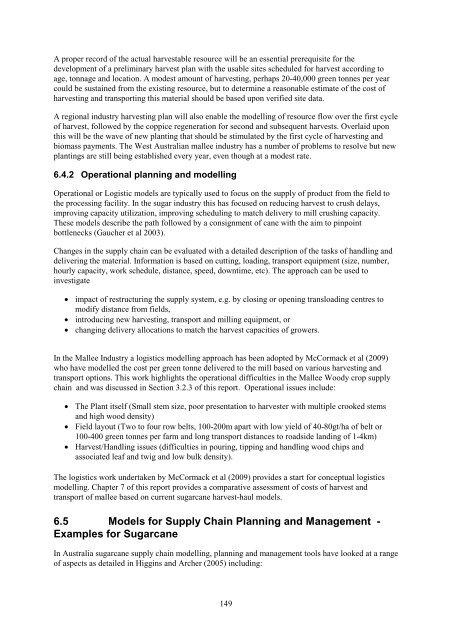Download (4Mb) - USQ ePrints - University of Southern Queensland
Download (4Mb) - USQ ePrints - University of Southern Queensland
Download (4Mb) - USQ ePrints - University of Southern Queensland
You also want an ePaper? Increase the reach of your titles
YUMPU automatically turns print PDFs into web optimized ePapers that Google loves.
A proper record <strong>of</strong> the actual harvestable resource will be an essential prerequisite for the<br />
development <strong>of</strong> a preliminary harvest plan with the usable sites scheduled for harvest according to<br />
age, tonnage and location. A modest amount <strong>of</strong> harvesting, perhaps 20-40,000 green tonnes per year<br />
could be sustained from the existing resource, but to determine a reasonable estimate <strong>of</strong> the cost <strong>of</strong><br />
harvesting and transporting this material should be based upon verified site data.<br />
A regional industry harvesting plan will also enable the modelling <strong>of</strong> resource flow over the first cycle<br />
<strong>of</strong> harvest, followed by the coppice regeneration for second and subsequent harvests. Overlaid upon<br />
this will be the wave <strong>of</strong> new planting that should be stimulated by the first cycle <strong>of</strong> harvesting and<br />
biomass payments. The West Australian mallee industry has a number <strong>of</strong> problems to resolve but new<br />
plantings are still being established every year, even though at a modest rate.<br />
6.4.2 Operational planning and modelling<br />
Operational or Logistic models are typically used to focus on the supply <strong>of</strong> product from the field to<br />
the processing facility. In the sugar industry this has focused on reducing harvest to crush delays,<br />
improving capacity utilization, improving scheduling to match delivery to mill crushing capacity.<br />
These models describe the path followed by a consignment <strong>of</strong> cane with the aim to pinpoint<br />
bottlenecks (Gaucher et al 2003).<br />
Changes in the supply chain can be evaluated with a detailed description <strong>of</strong> the tasks <strong>of</strong> handling and<br />
delivering the material. Information is based on cutting, loading, transport equipment (size, number,<br />
hourly capacity, work schedule, distance, speed, downtime, etc). The approach can be used to<br />
investigate<br />
• impact <strong>of</strong> restructuring the supply system, e.g. by closing or opening transloading centres to<br />
modify distance from fields,<br />
• introducing new harvesting, transport and milling equipment, or<br />
• changing delivery allocations to match the harvest capacities <strong>of</strong> growers.<br />
In the Mallee Industry a logistics modelling approach has been adopted by McCormack et al (2009)<br />
who have modelled the cost per green tonne delivered to the mill based on various harvesting and<br />
transport options. This work highlights the operational difficulties in the Mallee Woody crop supply<br />
chain and was discussed in Section 3.2.3 <strong>of</strong> this report. Operational issues include:<br />
• The Plant itself (Small stem size, poor presentation to harvester with multiple crooked stems<br />
and high wood density)<br />
• Field layout (Two to four row belts, 100-200m apart with low yield <strong>of</strong> 40-80gt/ha <strong>of</strong> belt or<br />
100-400 green tonnes per farm and long transport distances to roadside landing <strong>of</strong> 1-4km)<br />
• Harvest/Handling issues (difficulties in pouring, tipping and handling wood chips and<br />
associated leaf and twig and low bulk density).<br />
The logistics work undertaken by McCormack et al (2009) provides a start for conceptual logistics<br />
modelling. Chapter 7 <strong>of</strong> this report provides a comparative assessment <strong>of</strong> costs <strong>of</strong> harvest and<br />
transport <strong>of</strong> mallee based on current sugarcane harvest-haul models.<br />
6.5 Models for Supply Chain Planning and Management -<br />
Examples for Sugarcane<br />
In Australia sugarcane supply chain modelling, planning and management tools have looked at a range<br />
<strong>of</strong> aspects as detailed in Higgins and Archer (2005) including:<br />
149
















